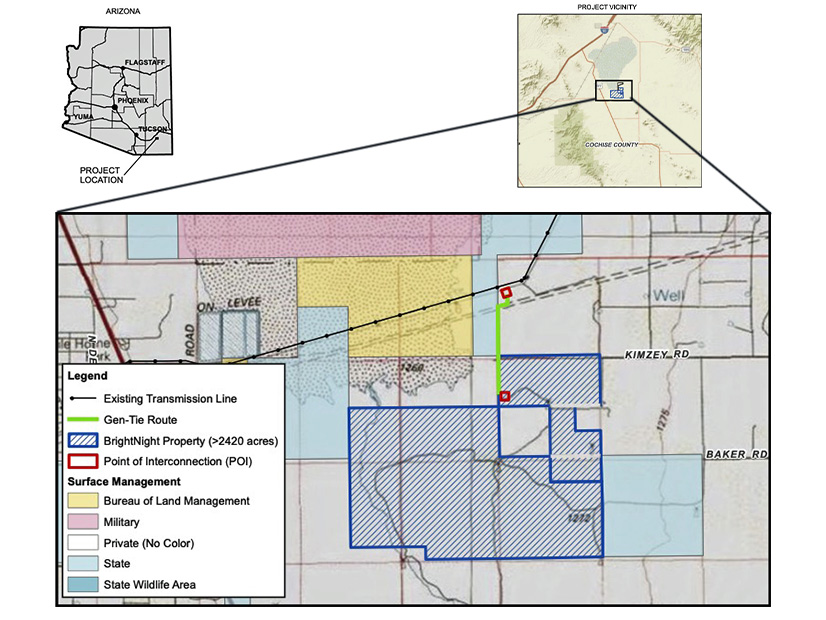FERC is moving to grant a solar developer’s request to force the Arizona Electric Power Cooperative to allow interconnection.
FERC is moving to grant a solar developer’s request to force the Arizona Electric Power Cooperative to allow interconnection.
The proposed order FERC issued Thursday gives AEPCO and developer THSI 30 days to negotiate the terms. If FERC finds the terms acceptable, it will issue a final order reflecting them. If the two sides are unable to reach agreement, FERC will prescribe the terms, consider the two sides’ positions, then issue a final order.
Docket TX23-5-000 centers on the Three Sisters Solar Project, a 300-MW solar array with 300 MW/1,200 MWh of battery storage proposed in southeast Arizona by BrightNight and its subsidiary, THSI.
THSI formally submitted the interconnection request to AEPCO in November 2019. After multiple studies, the dispute arose. In May 2023, AEPCO notified THSI it had removed Three Sisters from the interconnection queue.
In June 2023, THSI asked FERC to direct AEPCO to provide interconnection, finalize the large generator interconnection agreement and restore Three Sisters to its position in the queue.
From early July to early September, AEPCO protested; three industry associations (American Public Power Association, Large Public Power Council and National Rural Electric Cooperative Association) sought to intervene, then also jointly protested; and THSI, AEPCO and the power authorities then filed successive arguments, protests and responses to each other’s filings.
FERC’s proposed order includes the following points and counterpoints by the two sides:
THSI said it originally proposed an Aug. 2, 2022, commercial operation date, then early this year proposed Dec. 15, 2025. It said AEPCO initially raised no concerns but on May 16, 2023, said the new date was a material modification that would necessitate a new interconnection study, and that Three Sisters had been removed from the queue.
Informal dispute resolution attempts were unsuccessful, THSI said.
THSI said all necessary interconnection studies had been performed and found no potential reliability issues and no significant need for network system upgrades. Further, the parties had already negotiated a large generator interconnection agreement.
So, there is little else to discuss, THSI said.
But AEPCO countered there are genuine issues of material fact because there is no certainty whether or how much Three Sisters would serve the wholesale market.
AEPCO said THSI’s initial interconnection request made no mention of something that later came up in a state environmental review: a co-located green hydrogen production facility that would be an off-taker for the solar power generated there. This makes Three Sisters’ grid output uncertain, it said.
But THSI has not secured the right to serve a retail load such as the hydrogen plant, AEPCO said, adding that an AEPCO member has state approval to provide power to the plant.
(THSI counters that there is no binding agreement with the hydrogen facility potentially to be built on site.)
AEPCO says there is no controversy over its willingness to interconnect with THSI, only over whether it must maintain THSI’s position in the queue.
AEPCO questioned whether the public interest is served by allowing a developer to hold an interconnection queue position for more than five years, potentially to the detriment of other developers, for a project that might provide only behind-the-meter power to an industrial end-use off-taker.
AEPCO also laid out multiple reasons it believes FERC lacks jurisdiction to consider the matter. (The power associations made similar arguments. THSI offered counterarguments.)
AEPCO asked FERC to dismiss THSI’s request with prejudice, preserve its right to update the studies and allow it to participate in evidentiary hearings if the matter is not dismissed.
In its proposed order, FERC explains why it does have authority to consider THSI’s request, then explains why it is granting the request.
FERC said it finds the public interest would be served by directing AEPCO to provide interconnection service to THSI because precedent holds that transmission availability enhances competition in power markets, which should result in lower prices for consumers.
A potential future hydrogen facility does not necessitate new interconnection studies, FERC said, because THSI has made no changes to its 300-MW interconnection request.
Nor is there any genuine issue of material fact that would call for an evidentiary hearing, FERC wrote.


